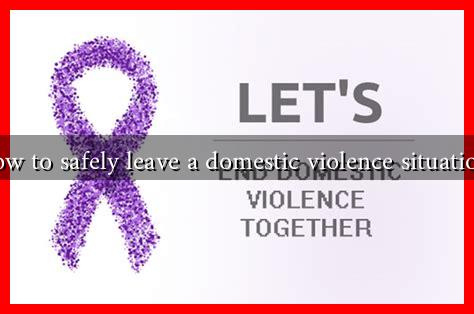-
Table of Contents
How to Safely Leave a Domestic Violence Situation
Leaving a domestic violence situation is a critical and often dangerous decision. Victims may feel trapped, fearful, and unsure of how to proceed. However, with careful planning and support, it is possible to escape safely. This article provides a comprehensive guide on how to navigate this challenging process, ensuring safety and well-being.
Understanding Domestic Violence
Domestic violence is a pattern of abusive behavior in a relationship used by one partner to gain or maintain control over another. It can take many forms, including physical, emotional, psychological, and financial abuse. According to the National Coalition Against Domestic Violence (NCADV), nearly 1 in 4 women and 1 in 9 men experience severe intimate partner physical violence. Understanding the dynamics of domestic violence is crucial for victims seeking to leave.
Recognizing the Signs
Before taking steps to leave, it is essential to recognize the signs of domestic violence. These may include:
- Physical harm or threats of violence
- Emotional manipulation or gaslighting
- Isolation from friends and family
- Financial control or abuse
- Intimidation or coercion
If you identify with these signs, it is vital to take your situation seriously and consider your options for leaving.
Creating a Safety Plan
A safety plan is a personalized, practical plan that includes ways to remain safe while in a relationship and when leaving. Here are key components to consider:
- Identify Safe Places: Know where you can go in an emergency, such as a friend’s house, a family member’s home, or a shelter.
- Pack an Emergency Bag: Include essential items such as clothing, medications, important documents (ID, birth certificates), and some cash.
- Establish a Code Word: Create a code word with trusted friends or family members to signal that you need help.
- Plan Your Exit: Choose a time when your partner is not home to leave. Consider the safest route to your destination.
- Contact Support Services: Reach out to local domestic violence shelters or hotlines for guidance and support.
Seeking Help and Support
Leaving an abusive relationship can be overwhelming, but you don’t have to do it alone. Here are some resources that can provide assistance:
- National Domestic Violence Hotline: Call 1-800-799-SAFE (7233) for confidential support and resources.
- Local Shelters: Many communities have shelters that offer safe housing and support services for victims of domestic violence.
- Counseling Services: Professional counseling can help you process your experiences and plan for the future.
For more information on local resources, visit the [National Coalition Against Domestic Violence](https://ncadv.org/). They provide a wealth of information on finding help in your area.
Legal Considerations
Understanding your legal rights is crucial when leaving a domestic violence situation. Consider the following:
- Restraining Orders: You may be able to obtain a restraining order to legally prevent your abuser from contacting you.
- Custody Arrangements: If children are involved, seek legal advice on custody and visitation rights.
- Documentation: Keep records of any incidents of abuse, including photographs, texts, and witness statements.
After Leaving: Building a New Life
Once you have left the abusive situation, focus on rebuilding your life. This may involve:
- Finding stable housing
- Seeking employment or financial independence
- Establishing a support network of friends and family
- Engaging in self-care and therapy to heal from trauma
Conclusion
Leaving a domestic violence situation is a courageous step that requires careful planning and support. By understanding the signs of abuse, creating a safety plan, seeking help, and knowing your legal rights, you can navigate this challenging process more safely. Remember, you are not alone, and there are resources available to help you reclaim your life. If you or someone you know is in a domestic violence situation, take action today to ensure safety and well-being.


